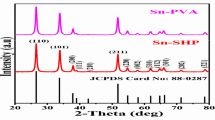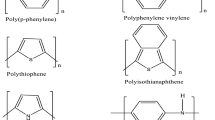Abstract
We have developed a new class of proton-conducting organic–inorganic hybrid silicophosphite membranes, produced by ethanol condensation of organically modified alkoxysilanes and anhydrous vinylphosphonic acid under solventless, catalyst-free, low-temperature, one-pot conditions. The membranes synthesized in this study are crack-free, large, and flexible, and they exhibit good thermal stability up to intermediate temperatures (~218 °C). Structural analyses using 29Si and 31P nuclear magnetic resonance spectroscopy and infrared measurements revealed that ethanol condensation produced an inorganic alternating copolymer structure, Si–O–P, with a phosphole group, and successive polymerization between vinyl and/or methacryl groups enabled these structures to connect with each other. In this way, it is possible to achieve structure manufacturing of inorganic–organic networks. The proton conductivities of the hybrids are as high as 5.2 × 10−3 S/cm at 85 °C under 80% relative humidity.













Similar content being viewed by others
References
R.P. Pereira, M.I. Felisberti, and A.M. Rocco: Intermolecular interactions and formation of the hydration sphere in phosphonic acid model systems as an approach to the description of vinyl phosphonic acid based polymers. Polymer (Guildf.) 47, 1414 (2006).
F. Sevil and A. Bozkurt: Proton conducting polymer electrolytes on the basis of poly(vinylphosphonic acid) and imidazole. J. Phys. Chem. Solids 65, 1659 (2004).
H. Erdemi and A. Bozkurt: Synthesis and characterization of poly(vinylpyrrolidone-co-vinylphosphonic acid) copolymers. Eur. Polym. J. 40, 1925 (2004).
J. Parvole and P. Jannasch: Polysulfones grafted with poly(vinylphosphonic acid) for highly proton conducting fuel cell membranes in the hydrated and nominally dry state. Macromolecules 41, 3893 (2008).
M. Yamada and I. Honma: Anhydrous proton conducting polymer electrolytes based on poly(vinylphosphonic acid)-heterocycle composite material. Polymer (Guildf.) 46, 2986 (2005).
H. Onizuka, M. Kato, T. Shimura, W. Sakamoto, and T. Yogo: Synthesis of proton conductive inorganic–organic hybrid membranes through copolymerization of dimethylethoxyvinylsilane with vinylphosphonic acid. J. Sol-Gel Sci. Technol. 46, 107 (2008).
T. Yazawa, T. Shojo, A. Mineshige, S. Yusa, M. Kobune, and K. Kuraoka: Solid electrolyte membranes based on polyvinyl phosphonic acid and alkoxysilane for intermediate-temperature fuel cells. Solid State Ion 178, 1958 (2008).
C.J. Brinker and G.W. Scherer: Sol-Gel Science (Academic Press, San Diego 1990).
H. Niida, M. Takahashi, T. Uchino, and T. Yoko: Preparation and structure of organic–inorganic hybrid low melting phosphite glasses from phosphonic acid H3PO3. J. Mater. Res. 18, 1081 (2003).
H. Niida, M. Takahashi, T. Uchino, and T. Yoko: Preparation of organic–inorganic hybrid precursors O=P(OSiMe3) x(OH)3–x for low-melting glasses. J. Ceram. Soc. Jpn. 111, 171 (2003).
M. Takahashi, H. Niida, Y. Tokuda, and T. Yoko: Organic–inorganic hybrid phosphite low-melting glasses for photonic applications. J. Non-Cryst. Solids 326, 524 (2003)
H. Niida, M. Takahashi, T. Uchino, and T. Yoko: Preparation and structure of organic–inorganic hybrid precursors for new type low-melting glasses. J. Non-Cryst. Solids 306, 292 (2002).
M. Megumi, M. Takahashi, Y. Tokuda, and T. Yoko: Organic–inorganic hybrid material of phenyl-modified polysilicophosphate prepared through nonaqueous acid-base reaction. Chem. Mater. 18, 2075 (2006).
M. Suzuki, M. Takahashi, Y. Tokuda, and T. Yoko: Preparation of optically functional organic–inorganic hybrid thin films through non aqueous acid-base reaction, in 45th Symposium on Basic Science of Ceramics, Sendai, Japan, 2007.
Y. Tokuda, Y. Tanaka, M. Takahashi, R. Ihara, and T. Yoko: Silicophosphate/silicophosphite hybrid materials prepared by solventless ethanol condensation. J. Ceram. Soc. Jpn. 117, 842 (2009).
C.F. Lorenzo, L. Esquivias, P. Barboux, J. Maquet, and F. Taulelle: Sol-gel synthesis of SiO2–P2O5 glasses. J. Non-Cryst. Solids 176, 189 (1994).
Z. Olejniczak, M. Łączka, K. Cholewa-Kowalska, K. Wojtach, M. Rokita, and W. Mozgawa: 29Si MAS NMR and FTIR study of inorganic-organic hybrid gels. J. Mol. Struct. 744, 465 (2005).
A.G. Kannan, N.R. Choudhury, and N.K. Dutta: Synthesis and characterization of methacrylate silicophosphite hybrid for thin film applications. Polymer (Guildf.) 48, 7078 (2007).
N.B. Colthup, L.H. Daly, and S.E. Wiberley: Introduction to Infrared and Raman Spectroscopy, 3rd ed. (Academic Press, San Diego 1990).
W. Förner and H.M. Badawi: Study of theoretical vibrational spectra and their assignments in vinylphosphonic and vinylthiophosphonic acids. J. Theor. Comput. Chem. 7, 1251 (2008).
P. Coloban and A. Novak: Proton transfer and superionic conductivity in solids and gels. J. Mol. Struct. 177, 277 (1988).
ACKNOWLEDGMENTS
This work was financially supported by the Joint Project of Chemical Synthesis Core Research Institutions Research and Education Funding for inter-University Research Projects, MEXT, Japan, and partially supported by a Grant-in-Aid for Scientific Research, No. 20613007, and Exploratory Research and Mission Research Project for Sustainable Humanosphere Science, Kyoto University. This work is also supported by Grant-in-Aid for Scientific Research (C), No. 20613007, MEXT. One of the authors (Y.T.) acknowledges financial support from the Murata Science Foundation.
Author information
Authors and Affiliations
Corresponding author
Rights and permissions
About this article
Cite this article
Tokuda, Y., Oku, S., Yamada, T. et al. Structure manufacturing of proton-conducting organic–inorganic hybrid silicophosphite membranes by solventless synthesis. Journal of Materials Research 26, 796–803 (2011). https://doi.org/10.1557/jmr.2010.89
Received:
Accepted:
Published:
Issue Date:
DOI: https://doi.org/10.1557/jmr.2010.89




